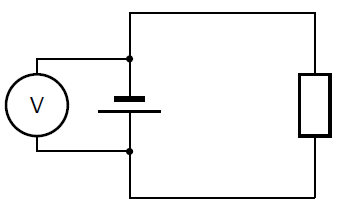| << Chapter < Page | Chapter >> Page > |
When a circuit is connected and complete, charge can move through the circuit. Charge will not move unless there is something to make it move. Think of it as though charge is at rest and something has to push it along. This means that work needs to be done to make charge move. A force acts on the charges, doing work, to make them move. The force is provided by the battery in the circuit.
We call the moving charge "current" and we will talk about this later.
The amount of work done to move a unit charge from one point to another point in a circuit is called the potential difference between those two points. You can think of it as a difference in the potential energy of the unit charge due to its position in the circuit. The difference in potential energy, called potential difference, is equal to the amount of work done to move the unit charge between the two points. Just like with gravity, when you raise an object above the ground it has gravitational potential energy due to its position, the same goes for a charge in a circuit and electrical potential energy. Potential difference is measured between or across two points. We do not say potential difference through something.
Electrical potential difference is the difference in electrical potential energy per unit charge between two points. The unit of potential difference is the volt named after the Italian physicist Alessandro Volta (1745–1827) (V). The potential difference of a battery is the voltage measured across it when current is flowing through it.
The unit of potential difference is the volt (V), which is the same as 1 joule per coulomb, the amount of work done per unit charge. Electrical potential difference is also called voltage.
We use an instrument called a voltmeter to measure the potential difference between two points in a circuit. It must be connected across the two points, in parallel to that portion of the circuit as shown in the diagram below.

When you use a voltmeter to measure the potential difference across (or between) the terminals of a battery, when no current is flowing through the battery, you are measuring the electromotive force (emf) of the battery. This is how much potential energy the battery has to make charges move through the circuit. It is a measure of how much chemical potential energy can be transferred to electrical energy in the battery. This driving potential energy is equal to the total potential energy drops in the circuit. This means that the voltage across the battery is equal to the sum of the voltages in the circuit.
You have now learnt that the emf is the voltage measured across the terminals of a battery when there is no current flowing through it and that the potential difference of a battery is the voltage measured across it when there is current flowing through it. So how do these two quantities compare with each other?

Notification Switch
Would you like to follow the 'Siyavula textbooks: grade 10 physical science [caps]' conversation and receive update notifications?